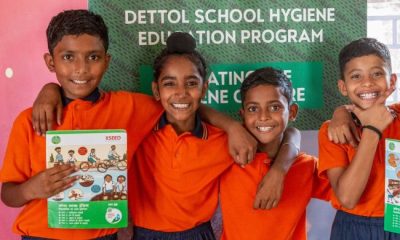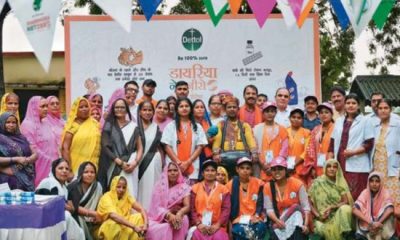New Delhi: “When one hears that India has the maximum number of malnutrition children in the world and the progress of the world to meet the Sustainable Development Goals depends on the progress of India, what does one do? What do you do, knowing around 45 per cent of deaths among children under age five are linked to undernutrition? Buckle up, and work towards it. There is no reason why India, inspite of being one of the fastest growing economies, still has malnourished children,” said Shashanka Ala, the Deputy Commissioner of Lawngtlai, Mizoram’s most backward and disaster-prone district.
Also Read: International Women’s Day Special: Why Is Nutrition Important For Women’s Health, Experts
Ms. Ala notes that as per the state government data, Lawngtlai has 35.3 per cent stunted, 21.3 per cent underweight and 5.9 per cent severely wasted (low weight-for-height) children under the age of 5, which is the highest in Mizoram. After a personal experience in the district as soon as she was posted here, Ms. Ala implemented the ‘My School My Farm’ initiative, where in order to improve the nutritional status of the meals served in schools, she proposed growing vegetables in the campus. She explains,
As I joined as the Deputy Commissioner of Lawngtlai, Mizoram, I enrolled my one-year-old son in the nearest anganwadi. Though I was happy that he was making new friends in the neighbourhood, I saw that he was coming home with take home ration in small packets, mostly of rice and dal. So, the first intervention was to make sure that hot cooked meals are served in the anganwadis. Further enquiry revealed that majority of the children in the anganwadi and schools were undernourished. A new and lactating mother myself and a strong advocator of exclusive breastfeeding, I could immediately link it to the unavailability of fresh fruits and vegetables and the inadequate infrastructure to cook a hot meal in the schools and anganwadis. This was when I realised that the problem is bigger than it looks. Upon multiple discussions with the stakeholders, community NGOs, church elders, we designed a programme that addresses the problem of unavailability and costly vegetables. This programme is called “Kan Sikul, Kan Huan” or My School, My farm.
Under the program, anganwadis and schools in the district were provided with sufficient open space, seeds, compost and other gardening equipment. The program with the ultimate objective of the producing vegetables on their own also taught an important lesson to the children about dignity of labour, Ms. Ala says.
Also Read: All About Food Fortification And How It Can Make India A Healthy Country
The curriculum was also redesigned to include one hour of Socially Useful Productive Work (SUPW) every day, so the children also become the stakeholder in the production while learning important life lessons.
The pilot project implemented in July 2019 was extremely successful and results were encouraging. It was later decided to launch this programme in all the anganwadis and schools of the district. Now we have A steady flow of fresh vegetables which help children in improving their dietary habits which stay with them for life.
When it comes to the monitoring of the programme, Ms Ala explains that the District Level Executive Committee meets on 5th of every month to discuss the progress of the project and discuss the way forward. There is also a Block level committee which ensures that any hurdles that arise are solved at the block level.
To motivate the stakeholders like the students and schools, Ms. Ala says that they organise various awards as incentives for the best nutrition gardens in the district.
Also Read: Rasoi On Wheel: This Mobile Kitchen Serves Nutritious Food To The Poor In Delhi And Gurugram
When it comes to the future of Ms. Ala’s ‘My School My Farm’, she shares,
The seamless integration of the supply chain, especially compost and seeds are on the cards. The plan is to achieve this with upgradation of Self Help Groups dealing with them to technically train them and make them self-sufficient. Phase III of the project aims to add livestock and poultry to the schools so as to improve their protein content in the diet.
The most important factor however lies in the sustainability and maintenance of the little gardens, Ms Ala asserts.
Nutrition garden project ensures to provide children with a real time look at how fruits and vegetables are grown and also turn into a recreational work experience in a hands-on learning environment. Here, they will learn to nurture nature and understand the correlation between work and harvest. Additionally, it is an outdoor activity respite that is educational, health and environment friendly for children growing up in a world where they are engrossed in gadgets and technology. I hope that the new generation learn to be one with nature by their example and are grounded and healthy. That’s the best gift I would give my child and every other child in this country.
Also Read: In A First, To Tackle Malnutrition, Odisha Introduces A Separate Nutrition Budget
Ms. Ala, being a mother of a toddler, further discussed her vision for a malnutrition-free India to save millions of children like her own, she said,
Poshan Abhiyan is exactly the right push, we needed in order to fight malnutrition in India. First 1000 days of every child, 9 months in the womb with the first and the second year, are the most crucial for everything this country wants to achieve. If a child is malnourished, his health and learning ability is reduced, thus, he cannot achieve his potential in his youth leaving the country’s demographic dividend as a mere liability.
She further explains that this status implies that, any interventions in health, education, sports, human resource, education, skill development, social welfare will not be completely successful until our children are fully ready to grasp the same. The learning outcomes of teachers and children in most rural areas are limited, mostly because they are malnourished and cannot cope up, she says.
Therefore, right now, amidst all the sectors, eradicating malnutrition should be among the top most priority for the government of India.































Anil Narula
September 2, 2020 at 1:42 pm
It is great blog post. helpful and Informative blog. Thanks for sharing these information with us.